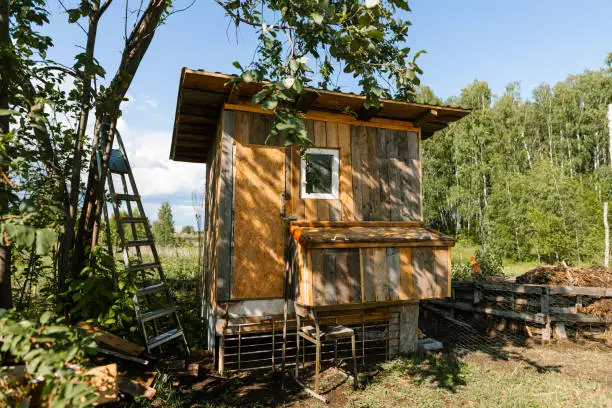You’ve decided to keep chickens. Good idea! Your backyard homesteading can provide fresh eggs, eccentric pets, and farm life. Those cluckers need a home first. Let’s discuss cheap chicken coop construction.
The Dream Blueprint
Sketch your ideal coop first. Grab some paper and a pencil—you don’t need to be an architect. Consider how many chickens you want—each needs 4 square feet in the coop and 10 in the run.
A simple, boxy style works well. There is no need for elaborate angles or turrets. Please keep it simple and valuable.
Material Matters
Gather supplies! Search your home and neighborhood for scrap wood, pallets, and furniture. Construction sites typically offer free timber.
Hardware stores are expensive, so try Habitat for Humanity ReStores or Craigslist. People sometimes sell outdated coops cheaply!
Foundational Basics
Your coop should be off the ground to avoid moisture and pests. For this, use concrete blocks or wooden posts.
Put hardware cloth under the foundation to keep burrowing predators out. Every raccoon knows chickens are egg treasure boxes!
Framing Fun
Build the frame with 2x4s—solid but cheap. Ensure everything is level and square to avoid a crooked building that may not last.
Add crossbeams for support and walls after the frame is solid.
Walls, Roofs
Wooden plywood sheets produce great walls at low cost. Secure them to your frame using screws or nails.
Durable corrugated metal sheets can be found cheaply for roofing. They also protect well from rain and snow.

Doors, Windows
Chickens stink, so every coop needs air. For safety, hardware cloth should replace glass in window openings.
A plywood door with a secure latch will do because predators are clever devils that adore nighttime nibbles!
Roosts and Nesting Boxes
Create nesting boxes for hens to deposit eggs in the coop—old milk crates work well! For warmth, line them with straw or wood shavings.
Raise roosting bars because chicks prefer sleeping above ground to avoid predators.
Predator Proofing
Reinforce gaps between boards or loose fittings around doors and windows where predators could enter.
An apron of hardware cloth extending from the base perimeter deters persistent diggers trying to dig under the fence line!
Remember to check frequently to ensure everything is secure, especially after storms. High gusts could loosen components and compromise safety. Flock inside a comfortable house constructed with loving hands. Yours sincerely proud owner, DIY masterpiece, economical fashionista, and feathery friends alike appreciate the effort that has gone into creating a haven.
Thus, this guide will help you build a budget-friendly chicken coop from scratch while providing top-notch shelter for beloved birds ready to raise backyard poultry. A sweet reward awaits.
Choosing the Best Chicken Breeds for Egg Production
The correct chicken breed is essential for filling your egg basket. Some hens lay well, while others are excellent for meat or decoration. Let’s explore the best breeds for omelets.
Leghorn—The Egg-Laying Machine
Think of Leghorns as high school overachievers. These birds lay eggs relentlessly. Small and white-feathered, they need less food than other breeds. An efficient mascot would be a Leghorn.
They lay 280-320 eggs annually. Nearly an egg daily! These are huge, white-shelled eggs. If you have a large family or love baking, Leghorns should be your first stop.
Rhode Island Red: All-Rounder
Rhode Island Reds are chicken Swiss Army knives. Hardy and adaptable, they work for eggs and meat. Today, we’re discussing their egg-laying skills.
These reddish-brown beauties lay 250–300 brown eggs annually. Resilience and climate adaptation are also their hallmarks. Rhode Island Reds will lay golden treasures in hot or cold weather.

Sussex—The Gentle Giant
Consider having a gentle giant in your backyard that lays eggs almost daily—the Sussex chicken. They make great pets due to their calmness and friendliness.
Sussex chickens lay 250-280 light brown eggs annually. Their colors include speckled, red, and white. Their versatility makes them suitable for meat and eggs, but take your time!
Plymouth Rock—The Reliable Layer
Plymouth Rocks are like that trustworthy buddy that always arrives when needed. These birds are peaceful, reliable layers.
These birds lay 200–280 giant brown eggs annually. Their stunning black-and-white banded feathers are attractive, too! They tolerate confinement well in coops with little room.
Australorp: Record Breaker
Australorps are famous—one hen laid 364 eggs in a year! Not every Australorp will reach such numbers, but this breed is still productive.
These black-feathered birds lay 250-300 light brown eggs annually. They’re calm and kind, making them ideal for families.
Orpington: Fluffy Friend
Orpingtons are plush walking pillows with feathers—soft, cozy, and excellent layers! Colors include buff (most frequent), black, blue, and white.
Orpingtons typically lay 200–280 medium-sized brown eggs annually. Their calmness makes them suitable for backyard flocks with regular human interaction.
Wyandotte—The Showstopper
Wyandottes are productive and elegant with braided silver or gold plumage.
These birds produce 200-240 huge brown eggs annually and add aesthetic value to any flock due to their remarkable appearance!
Easter Egger: Colorful Layer
Easter Eggers lay multicolored pastel gems from blue to green that are both visually appealing and healthy!
They produce 180–200 multicolored eggs yearly, making them less prolific than others, but it is still worth considering if uniqueness is essential to individual preferences!
ISA Brown: Commercial Powerhouse
ISA Browns were bred for commercial use, and because of their steady high output rates throughout their existence, they’re found on farms globally.
Keeping chickens at home for fresh eggs and farm life is excellent. Build a cheap chicken coop! First, sketch your ideal coop, giving each chicken 4 square feet in the coop and 10 in the run. Keep it essential and valuable. Find scrap wood, pallets, and furniture. Search Craigslist, Habitat for Humanity ReStores, and building sites for free or cheap materials.
Elevate the coop with concrete blocks or wooden supports to avoid bugs and wetness. Hardware cloth under the foundation deters burrowers. Use 2x4s to build a square, level frame. Build walls using plywood and roofs with corrugated metal. Replace glass windows with hardware cloth for ventilation. A plywood door and latch secure the coop.
Line old milk crates with straw or wood shavings for nesting boxes. Install fowl roosting bars above the ground. To prevent predators from tunneling under the fence, reinforce gaps and apply a hardware cloth apron. Check security regularly, especially after storms. Have fun with your DIY coop and backyard fowl!
Selecting Egg-Producing Chicken Breeds
Choose the correct chicken breed for your egg basket. High school overachievers Leghorns lay 280-320 white eggs annually, making them efficient layers. Rhode Island Reds are resilient, laying 250–300 brown eggs annually. Gentle giant Sussex chickens produce 250-280 light brown eggs yearly and make terrific pets.
Plymouth Rocks, consistent layers, lay 200-280 giant brown eggs annually. Famous for their record-breaking egg-laying, Australorps lay 250-300 light brown eggs annually. Fluffy Orpingtons lay 200-280 medium-sized brown eggs yearly and are suitable for backyard flocks.
Silver or gold-plumed Wyandottes lay 200–240 giant brown eggs annually. Easter Eggers produce 180–200 colorful eggs each year, adding beauty. Commercial powerhouse ISA Browns produce eggs prolifically due to their constant output.





Leave a Reply
You must be logged in to post a comment.